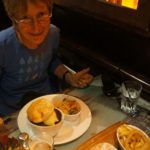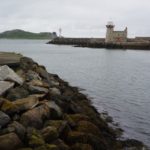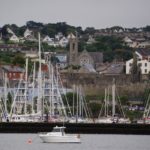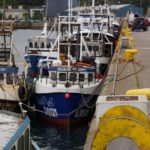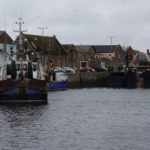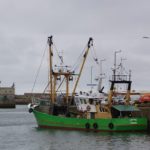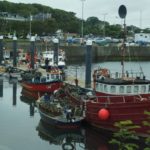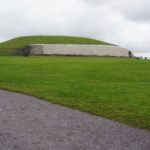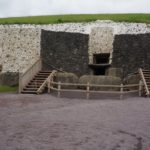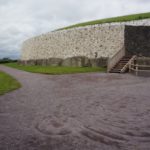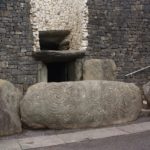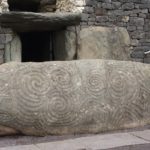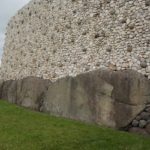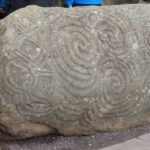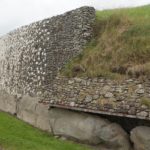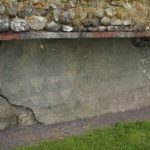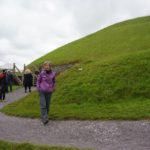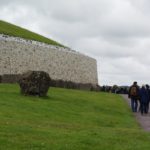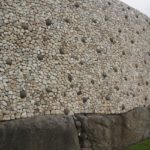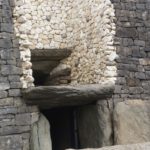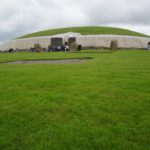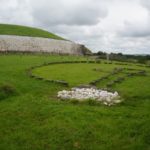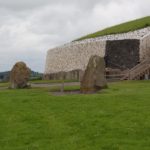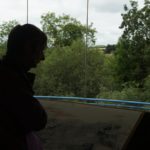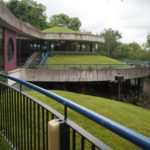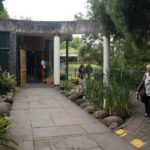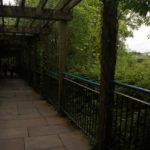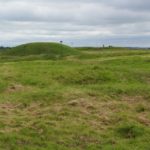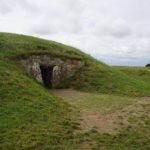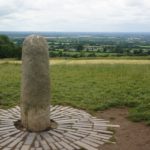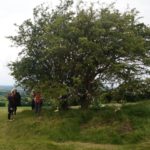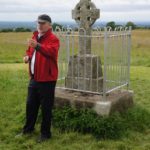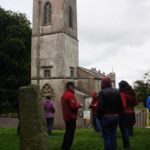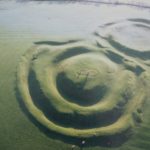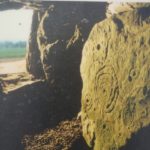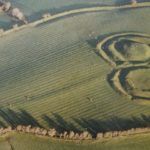An early start today. Much, much earlier than we wanted. We were both awake at 4.30am. Not because it was light and bright outside and all bedrooms in Ireland have the most flimsy transparent curtains but because outside there were dozens of screeching and squawking sea gulls. When we were at the Charles Stewart 5 weeks ago we didn’t notice the birds but then we were on the main street side of the hotel. This time we face a back alley and I think the sea gulls are scrounging for food down there.
Today was a busy but most interesting day. Before leaving NZ we had booked a one day bus tour to Howth, Newgrange and The Hills of Tara. 41 of us (15 nationalities) and Eoin the driver and guide.
Howth is a seaside village and outer suburb of Dublin at the north end of Dublin Bay. It was a morning tea stop with just enough time to look at the fishing boats in the harbor but not enough time to get to an abbey ruin, a Martello Tower, an interesting church etc. For us it wasn’t of great interest as we had seen some much prettier and more interesting villages in SW Ireland. The most entertaining event was as we were about to leave in the bus, a large truck with a catch of fish parked alongside us. It was immediately swarmed over by hundreds of large gulls. The guys kept on unloading the truck but the gulls were everywhere, getting into the truck, into the crates, flying off with mouthfuls of fish. It was all a bit scary, reminiscent of Alfred Hitchcock’s movie The Birds.
Next stop was Newgrange and this is probably the most awesome and most interesting place I have seen in Ireland. It is a 5,200 year old passage tomb located on a hill in the Boyne Valley. The experience is very well organized. The bus and car park are located a little way from an excellent visitor centre/café/souvenir shop. The walk is through a pergola under some trees. At one point, if you are looking, there is a glimpse through the trees of the hillside with the mound containing the tomb. The visitor centre itself is half buried in the ground and is a series of circles with grass roofs, so it also looks like a mound. Here you buy tickets (ours were part of the tour deal) and you are organized into time slots of 15 minutes. Then there is a walk through more trees and over a bridge on the Boyne River to waiting mini buses. The buses then take you, in your time slots, about 2km up to the tomb site. There each group (about 20 people) is met by a guide and you get a talk for about 10 minutes on what Newgrange is all about – as far as they know. The guide then takes the group inside, up a 19m long, low, narrow rising passage to the central chamber. More explanation from the guide and then the lights are turned out and starting from total blackout there is a simulation of the winter solstice sun (Dec 21) entering the passage and the chamber. This very dramatic. Each group gets 10 minutes in the tomb before you file out. Unfortunately no photography allowed inside the tomb.
Newgrange was built by Stone Age (Neolithic) farmers and is called a passage tomb but is also thought to be a place of religious, ceremonial, astrological and spiritual importance. It is a mound 85 metres in diameter and 13.5 metres high. The base around the perimeter is retained by 97 large kerbstones some of which are decorated with megalithic art. Part of the perimeter is faced with white quartz stones which makes it look quite dramatic with the green of the grass over the top of the mound. A stone lined and roofed passage leads to a chamber with three alcoves. The chamber has a 6 metres high corbelled roof of diminishing diameter. In each of the alcoves is a large bowl shaped granite stone. The exterior front wall has been reconstructed from existing fallen material and there is some controversy about this.
In the wall above the entrance is an opening called a roof box. Its purpose is to allow sunlight to penetrate the chamber on the shortest days of the year, around December 21st, the winter solstice. At dawn, from December 19th to 23rd, a narrow beam of light penetrates the roof-box and reaches the floor of the chamber, gradually extending to the rear of the chamber. As the sun rises higher, the beam widens within the chamber so that the whole room becomes dramatically illuminated. This event lasts for 17 minutes, beginning around 9am. This is quite remarkable as Newgrange was built 500 years before the Great Pyramids and 1,000 years before Stone Henge.
After this we went to The Hills of Tara. This is Ireland’s most revered ancient landscape of huge symbolic importance. It looks very underwhelming being a hill with a series of grassed humps and trenches with a small standing stone, a very small passage tomb (which you can’t go into), a Celtic cross, a statue of St Patrick and a chapel converted to a visitor’s centre. Tara started as the chief pagan sanctuary and communal burial place of early Ireland, about 4,000BC. The five principal roads of Ancient Ireland converged on this place. Generation after generation added to its sacred significance. Eventually it was revered so much that the kings of Ireland’s medieval kingdoms were crowned here. Each royal kingdom is thought to have its own site here. To be crowned King of Tara was considered to be crowned king of all Ireland.
Our driver/guide gave us a long tour/history of the site but I think our minds were still at Newgrange and it was now a bit windy and cold. Archeology fatigue was starting to set in. We did learn about fairy trees. These are actually hawthorn trees and you often see them standing alone in fields. Farmers will not cut them down as that would let the fairies and their spells out. The trees are often circled with stones to further keep the spells in. People will also write wishes onto pieces of ribbon and tie them to Hawthorn trees in the hope of their wishes coming true.
A great day and for anyone visiting Ireland, in my opinion, Newgarnge is a must.
- Apple crumble with raspberries and custard – yummy!
- Howth
- Howth
- Howth
- Howth
- Howth
- Howth
- The coach
- The Birds
- The Birds
- Howth
- Newgrange
- Newgrange entry
- Newgrange
- Newgrange entry
- Newgrange entry stone
- Kerbstones, Newgrange
- Entry stone
- Newgrange
- Decorated kerbstone
- Newgrange, decorated kerbstone
- Newgrange
- Newgrange
- Quartz exterior wall
- The roof box above the entry
- Newgrange
- Newgrange
- Newgrange
- The mini buses, Newgrange
- Newgrange visible on hill
- Newgrange Visitor Centre
- Newgrange Visitor Centre
- Newgrange visible top right
- The Hill of Tara
- Passage Tomb, The Hill of Tara
- Stone where Kings of Ireland were crowned, The Hill of Tara
- Fairy (Hawthron) Tree, The Hill of Tara
- Guide Eoin and Celtic Cross
- Standing Stone, The Hill of Tara
- St Patrick
- The Hill of Tara from the air
- The Hill of Tara Passage Tomb
- The Hill of Tara from the air

